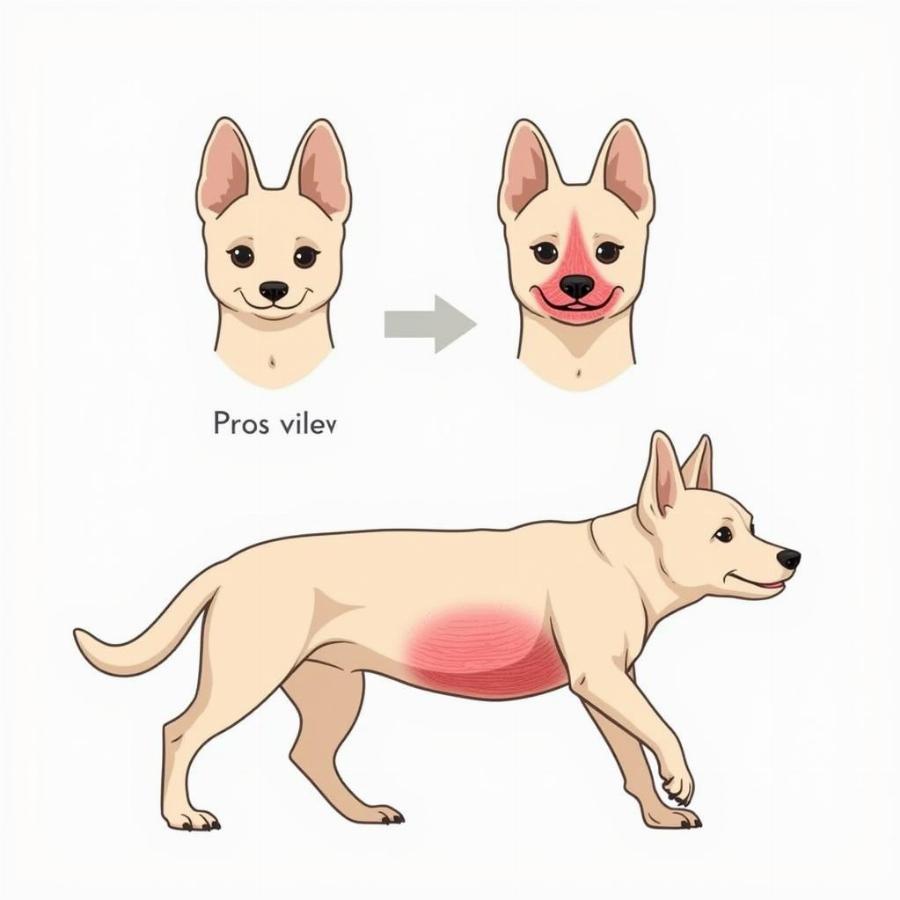A recessed dog vulva, sometimes referred to as a “hooded vulva,” is a relatively common anatomical variation where the vulva, the external part of the female dog’s reproductive system, is covered by a fold of skin. While often harmless, it’s important for owners to understand what a recessed vulva is, potential issues it can cause, and when to seek veterinary attention. This guide will cover all aspects of recessed dog vulvas, empowering you with the knowledge to ensure your dog’s health and well-being.
What is a Recessed Vulva in Dogs?
A recessed or hooded vulva sits deeper within the surrounding skin folds than a typical vulva. Think of it as being tucked in or partially hidden. This anatomical variation can occur in any breed but is more common in certain breeds such as Bulldogs, English Bulldogs, and Pugs. It’s generally present from birth and doesn’t change significantly over the dog’s life. Often, a recessed vulva doesn’t cause any problems. However, in some cases, it can lead to hygiene issues and potential health complications.
 Recessed Vulva Dog Anatomy Illustration
Recessed Vulva Dog Anatomy Illustration
Potential Problems Associated with a Recessed Vulva
While a recessed vulva itself is not a disease, it can create an environment conducive to bacterial growth and infections. The hidden nature of a recessed vulva can trap moisture, urine, and fecal matter, leading to skin irritation and infections. This can manifest as redness, swelling, discharge, and a foul odor. In some cases, recurrent urinary tract infections can also occur.
What to Look For: Signs of Infection
Knowing the signs of a potential infection is crucial for owners of dogs with recessed vulvas. Be vigilant and contact your veterinarian if you notice any of the following:
- Redness and swelling: The area around the vulva appears inflamed and irritated.
- Discharge: A yellowish or greenish discharge from the vulva is often a sign of infection.
- Foul odor: An unpleasant smell emanating from the vulva indicates a potential problem.
- Excessive licking: Your dog frequently licks the area, suggesting discomfort or irritation.
- Discomfort during urination: Your dog may strain, whine, or show signs of pain while urinating. This might also indicate a urinary tract infection.
Caring for a Dog with a Recessed Vulva
Proper hygiene is paramount for dogs with recessed vulvas. Regularly cleaning the area can help prevent infections and maintain your dog’s comfort. Here’s what you can do:
- Gentle cleaning: Use a warm, damp cloth or pet-safe wipes to clean the area around the vulva. Be sure to gently wipe away any debris or discharge.
- Keep the area dry: After cleaning, ensure the area is thoroughly dry to discourage bacterial growth.
- Trim surrounding fur: If the fur around the vulva is long, consider trimming it to keep the area cleaner and drier. This can be especially helpful for dogs with thick coats. Similar to how you would care for recessed vulva dogs, consistent cleaning is key.
- Monitor regularly: Check the area daily for any signs of redness, swelling, or discharge.
When to Seek Veterinary Attention
If you notice any signs of infection, such as redness, swelling, discharge, or a foul odor, it’s essential to contact your veterinarian. Just like addressing licking lips in dogs, addressing potential vulva issues promptly is crucial. They can diagnose the problem and recommend appropriate treatment, which might include antibiotics or other medications. In some cases, surgical correction may be an option to address a severely recessed vulva.
Surgical Correction for Recessed Vulva
In more severe cases where a recessed vulva is causing recurrent infections or significantly impacting the dog’s quality of life, a veterinarian might recommend surgical correction. This procedure involves removing some of the excess skin covering the vulva, making it more exposed and easier to keep clean. This can significantly reduce the risk of future infections. Like learning how to help dry skin on dogs, understanding surgical options is part of responsible pet ownership.
Conclusion
A recessed dog vulva is an anatomical variation that requires careful attention to hygiene and regular monitoring. While it often doesn’t cause problems, it’s important to be aware of potential issues and take proactive steps to prevent infections. By understanding the signs of infection and practicing proper hygiene, you can help keep your dog comfortable and healthy. If you have any concerns about your dog’s vulva, don’t hesitate to contact your veterinarian for advice and guidance regarding a recessed dog vulva.
FAQ
- Is a recessed vulva common? Yes, it is a relatively common anatomical variation in dogs.
- Does a recessed vulva always require surgery? No, surgery is only necessary in severe cases causing recurrent infections.
- How often should I clean my dog’s recessed vulva? Regular cleaning, especially after urination or defecation, is recommended.
- Can a recessed vulva affect a dog’s ability to breed? In some cases, it can make breeding more difficult, but not always impossible.
- What are the signs of a vulva infection in dogs? Redness, swelling, discharge, foul odor, and excessive licking are common signs.
- Can a recessed vulva be present in puppies? Yes, it is usually present from birth.
- What breeds are more prone to recessed vulvas? Brachycephalic breeds like Bulldogs and Pugs are more commonly affected.
Related Articles
You might also be interested in reading about rottweiler male dog.
Beaut Dogs: Your Trusted Source for Dog Care
Beaut Dogs is your one-stop resource for all things related to dog care. We provide comprehensive information and expert advice on various dog breeds, health issues, nutrition, training, and much more. When you need expert advice, contact us at Email: [email protected] to get detailed and accurate answers from Beaut Dogs. We’re dedicated to helping you provide the best possible care for your canine companion.